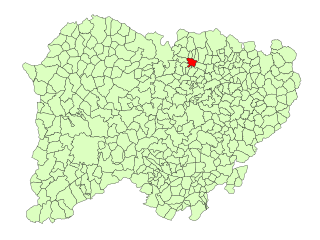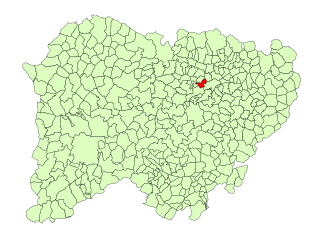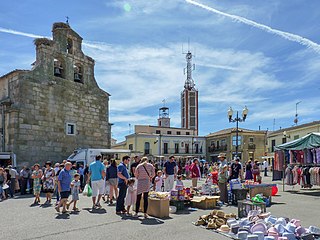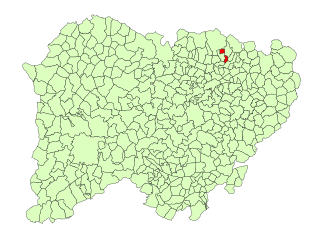
Salamanca is a province of western Spain, in the western part of the autonomous community of Castile and León. It is bordered by the provinces of Zamora, Valladolid, Ávila, and Cáceres, and on the west by Portugal. It has an area of 12,349 km² and in 2018 had a population of 331,473 people. It is divided into 362 municipalities, 11 comarcas, 32 mancomunidades and five judicial districts. Of the 362 municipalities, more than half are villages with fewer than 300 people.

Almenara de Tormes is a village and municipality in the province of Salamanca, western Spain, and is part of the autonomous community of Castile and León. It is located 18 kilometres (11 mi) from the city of Salamanca and has a population of 249 people. The municipality covers an area of 19 km2 (7.3 sq mi). The village lies 782 metres (2,566 ft) above sea level and the post code is 37115.

Calvarrasa de Abajo is a village and municipality in the province of Salamanca, western Spain, part of the autonomous community of Castile-Leon. It is 10 kilometres (6.2 mi) from the provincial capital city of Salamanca and has a population of 1,143 people. The municipality covers an area of 28 km2 (11 sq mi).

Cantalapiedra is a village and municipality in the province of Salamanca, western Spain, part of the autonomous community of Castile and León. It is located 50 kilometres (31 mi) from the city of Salamanca and has a population of 1250 people. The municipality covers an area of 25 km2 (9.7 sq mi).

Doñinos de Salamanca is a village and municipality in the province of Salamanca, western Spain, part of the autonomous community of Castile-Leon. It is located 7 kilometres (4.3 mi) from the provincial capital city of Salamanca and has a population of 1,996 people.

Horcajo de Montemayor is a village and municipality in the province of Salamanca, western Spain, part of the autonomous community of Castile-Leon. It is located 90 kilometres (56 mi) from the provincial capital city of Salamanca and has a population of 154 people.

El Pino de Tormes is a village and municipality in the province of Salamanca, western Spain, part of the autonomous community of Castile-Leon. It is located 19 kilometres (12 mi) from the provincial capital city of Salamanca and has a population of 157 people.

La Fuente de San Esteban is a village and large municipality in the province of Salamanca, western Spain, part of the autonomous community of Castile-Leon. It is located 54 kilometres (34 mi) from the provincial capital city of Salamanca and has a population of 1,358 people.

Peñaranda de Bracamonte is a village and municipality in the province of Salamanca, western Spain, part of the autonomous community of Castile-Leon. It is located 40 kilometres (25 mi) from the provincial capital city of Salamanca and has a population of 6320 people.

Encinas de Abajo is a village and municipality in the province of Salamanca, Spain, which is part of the autonomous community of Castile-Leon. It is located 17 kilometres (11 mi) from the provincial capital city of Salamanca, and had a population in 2016 of 666.

Negrilla de Palencia is a sparsely populated village and municipality in the province of Salamanca, western Spain, part of the autonomous community of Castile-Leon. It is located 17 kilometres (11 mi) from the provincial capital city of Salamanca and has a population of 97 people.

La Alberguería de Argañán is a village and municipality in the province of Salamanca, western Spain, part of the autonomous community of Castile-Leon. It is located 122 kilometres (76 mi) from the provincial capital city of Salamanca and as of 2016 has a population of 134 people.

Puebla de Yeltes is a village and municipality in the province of Salamanca, western Spain, part of the autonomous community of Castile-Leon. It is located 65 kilometres (40 mi) from the provincial capital city of Salamanca and has a population of 151 people.

Fuentes de Oñoro is a village and municipality in the province of Salamanca, western Spain, part of the autonomous community of Castile-Leon. It is located 124 kilometres (77 mi) from the provincial capital city of Salamanca, and has a population of 1058 people. It was the site of a significant battle in 1811, during the Peninsular War.

Hinojosa de Duero is a village and large municipality in the province of Salamanca, western Spain, part of the autonomous community of Castile-Leon. It is located 105 kilometres (65 mi) from the provincial capital city of Salamanca and has a population of 699 people.

Ituero de Azaba is a village and municipality in the province of Salamanca, western Spain, part of the autonomous community of Castile-Leon. It is located 108 kilometres (67 mi) from the provincial capital city of Salamanca and has a population of 235 people.

La Cabeza de Béjar is a mountainous village and [[Municipalities of Spain}municipality]] in the province of Salamanca, western Spain, part of the autonomous community of Castile and León. It is located 55 kilometres (34 mi) from the provincial capital city of Salamanca and has a population of 93 people.

La Calzada de Béjar is a village and municipality in the province of Salamanca, western Spain, part of the autonomous community of Castile and León. It is located 90 kilometres (56 mi) from the provincial capital city of Salamanca and has a population of 86 people.

Florida de Liébana is a village and municipality in the province of Salamanca, western Spain, part of the autonomous community of Castile-Leon. It is located 14 kilometres (8.7 mi) from the provincial capital city of Salamanca and has a population of 259 people.

Las Casas del Conde is a tiny village and municipality in the province of Salamanca, western Spain, part of the autonomous community of Castile-Leon. It is located 78 kilometres (48 mi) from the provincial capital city of Salamanca and has a population of only 55 people.




















